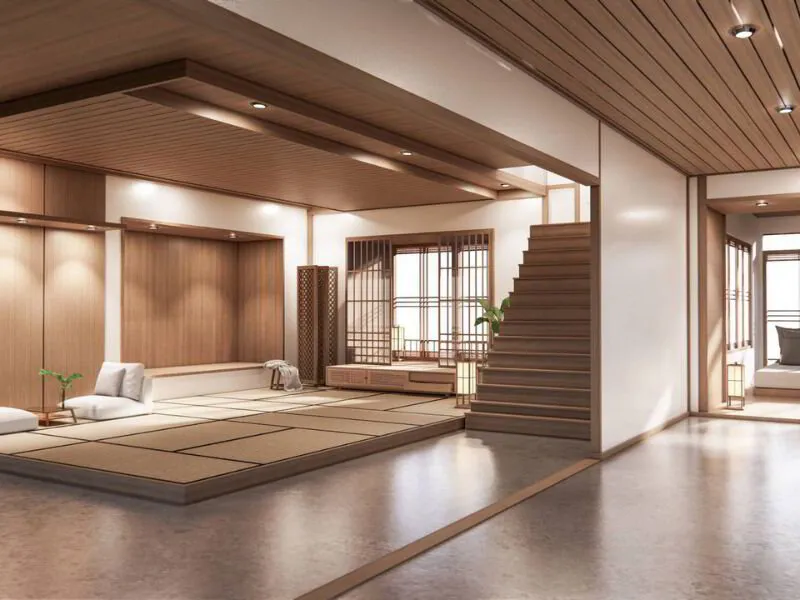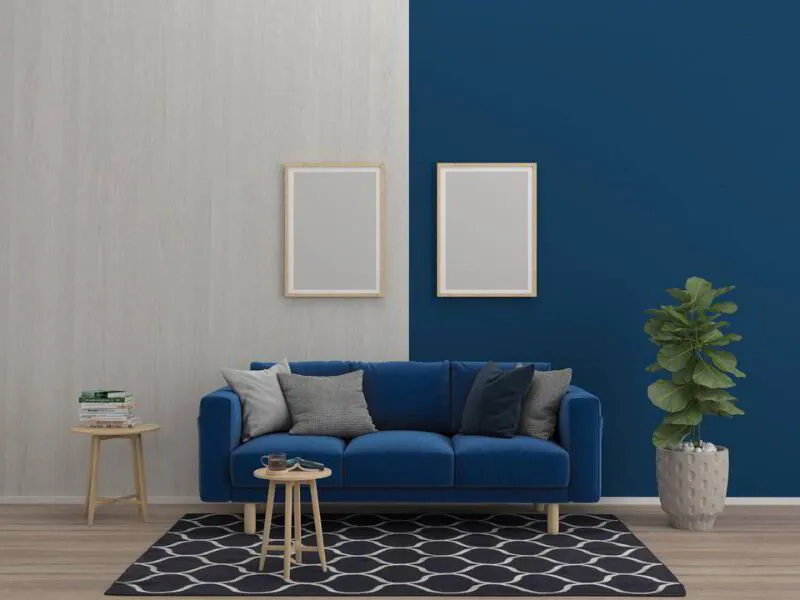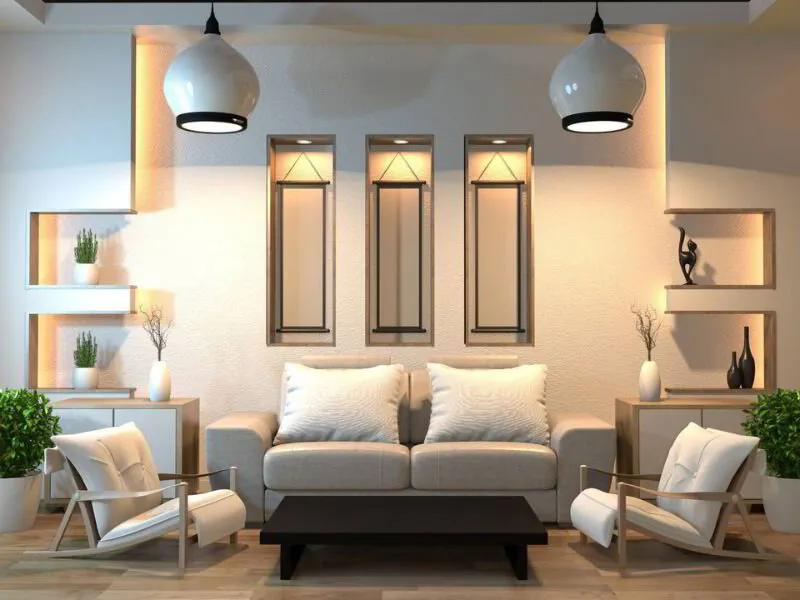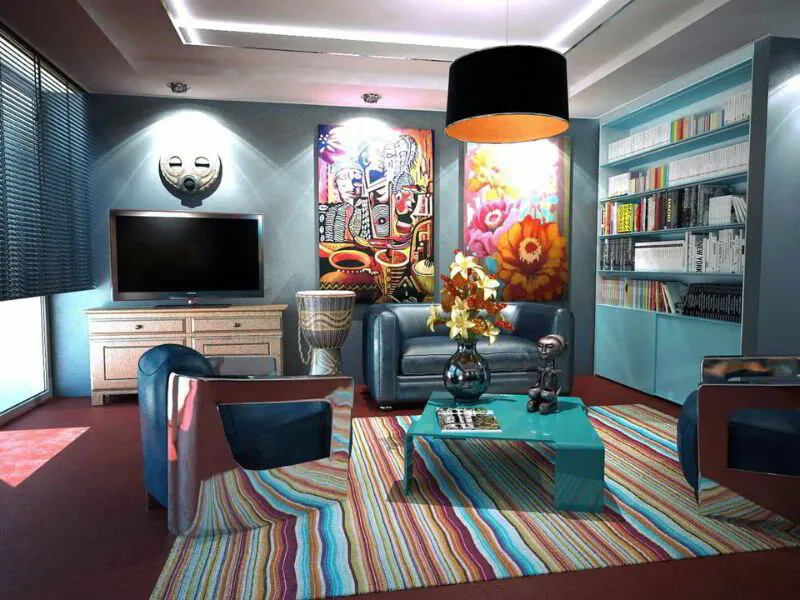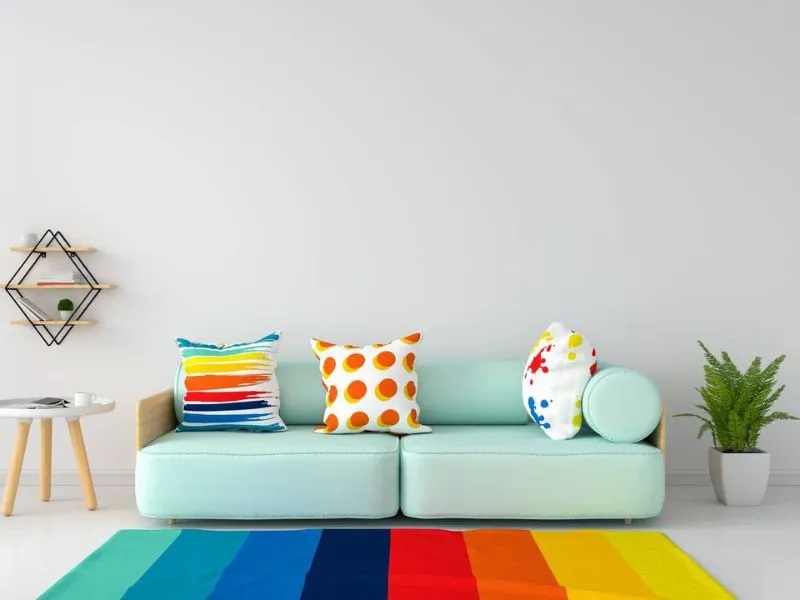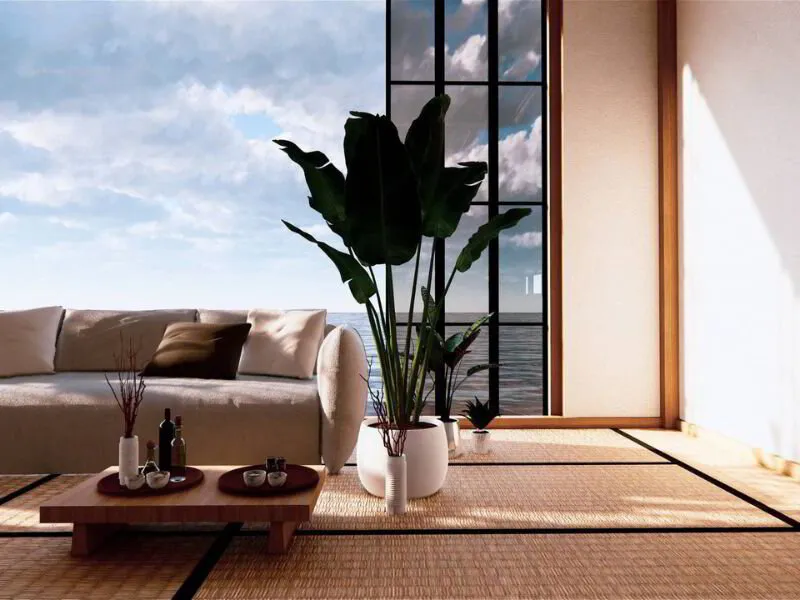Are you looking to add the perfect finishing touches to your home décor? Interior design is a powerful tool that can be used to turn any living space into an inviting, comfortable place.
Whether you're painting walls, selecting furniture, or creating subtle accents with textiles and accessories - there are key elements of interior design that will help ensure success.
In this blog post, we'll discuss the seven elements of interior design: space & lines, light & shadows, form, color palette, texture, and pattern, to create balance & harmony.
Get ready to enter the wonderful world of DIY interior designing!
📘 Key Takeaways
- Space Management: Understanding space, both positive and negative, is crucial for creating depth and personality in your rooms.
- Power of Lines: Lines can enhance visual interest, define spaces, and establish movement within a room.
- Form and Function: The form or shape of objects in a room contributes to balance and visual intrigue.
- Color and Light Interplay: Light is integral to setting a mood, defining space, and adding texture, while color can evoke emotions and highlight specific features.
- Texture and Pattern: Incorporating various textures adds dimension and interest, and using patterns creatively can enhance the overall room atmosphere.
What are the Basic Elements of Interior Design?
Interior design is an art form that combines the use of space, lines, form, light, color, texture, and pattern to create inviting and functional spaces. It considers how each element can create balance and harmony within a room.
The elements of space, shape, form, and lines are used to define the spatial characteristics of a room. At the same time, light, color, texture, and pattern bring character and identity to the atmosphere.
By combining these design elements, interior designers can create a unique aesthetic that reflects their individual style.
Related Reading: The Ultimate Glossary of Interior Design Terms
Element 1: Space
Space is an essential element in interior design that contributes to how a room looks and feels. By defining the boundaries of a space and utilizing the available area effectively, a designer can create an inviting and comfortable environment for those who inhabit it.
This allows designers to create both positive and negative space in a room.
Positive space can highlight furniture layout, artwork, and decorative accessories, while negative space provides an open and airy feel. By strategically placing furnishings within the available area, an interior designer can create distinct zones that offer visual interest without overcrowding the environment.
Playing with scale and proportion when designing these spaces allows for larger or smaller areas to balance out the overall look. Utilizing the right combination of positive and negative space can add depth, texture, and personality to any room design.
Related Reading: The Benefits of Good Space Planning in Interior Design
Real Life Example:
Imagine walking into a spacious loft apartment with high ceilings. The living area is anchored by a large, plush sectional sofa placed centrally, representing positive space.
This sofa is complemented by a statement coffee table and a few scattered floor cushions, creating a cozy conversation area. However, instead of filling every corner with furniture, the designer has left ample space around the seating area, which represents negative space.
This not only makes the room feel open and airy but also draws attention to a beautiful, oversized floor-to-ceiling window on one side, flooding the room with natural light.
To the right, a compact dining area with a round table and chairs is set, ensuring it doesn't compete with the living area but complements it. The spaces are distinct yet flow seamlessly, thanks to the strategic use of positive and negative spaces.
On the far end, a large piece of wall art hangs, drawing the eye upwards and emphasizing the room's height. This play on scale and proportion ensures that, despite the room's vastness, it feels intimate and connected.
In this setting, the designer has masterfully balanced both positive and negative spaces, ensuring the loft feels cohesive, inviting, and perfectly proportioned.
Element 2: Lines
Lines are a fundamental component of interior design and can be used for various purposes. Lines add visual interest to a space and draw attention to some aspects, like a room's focal point.
Lines can also define spaces and create movement within a room, visually opening up the space or creating intimate areas. Vertical lines can make a space appear taller or provide a sense of stability, while horizontal lines bring an air of calmness.
Dynamic lines help add movement to a room by leading eyes along interesting pathways and providing visual interest.
Lines should be used thoughtfully; straight lines tend to bring order and structure, whereas curved lines evoke softer feelings of comfort and relaxation. By strategically using lines, a designer can create an inviting atmosphere that is both aesthetically pleasing and functional.
Related Reading: The Ultimate Guide to Using Line in Interior Design
Real Life Example:
Imagine entering a modern open-concept living and dining area. Immediately, your eyes are drawn to a tall, vertical floor-to-ceiling bookshelf on the left wall, filled with books and decorative items.
These vertical lines not only emphasize the room's height but also provide a sense of grandeur and stability. In contrast, a long, low-profile wooden coffee table sits in the center of the living area, its horizontal lines bringing a sense of calmness and grounding the space.
Above the table, a geometric pendant light hangs, its angular lines adding a dynamic touch and drawing the eyes upward. As you move to the dining area, a large, round dining table takes center stage. Its curved lines evoke feelings of comfort and relaxation, making it an inviting spot for family gatherings.
The chairs around the table, with their sleek straight backs and legs, bring a sense of order and structure to the space. Finally, a winding staircase with a decorative wrought-iron railing leads to the upper floor.
The dynamic lines of the railing create movement, guiding the eyes along an interesting pathway and adding a touch of elegance.
In this setting, the designer has skillfully employed various lines - vertical, horizontal, curved, and dynamic - to craft a harmonious and visually appealing environment that caters to both form and function.
Element 3: Form
Form is an essential element of interior design. It refers to the visual shape and structure of objects in a room. Forms can create balance and movement throughout a space and define areas within larger rooms.
Using geometric forms like natural shapes, curves, or circles, interior designers can manipulate the direction people move through a space by creating pathways and adding depth and dynamism.
This can also add visual interest to a room as bold shapes or contrasting colors catch the eye. Using form, a designer can help make a space feel unique and inviting.
Related Reading: Using Form in Interior Design to Create a Unique and Beautiful Space
Real Life Example:
Imagine stepping into a contemporary hotel lobby. The first thing that catches your eye is a massive, geometric chandelier hanging from the ceiling.
Its angular, geometric form immediately adds a sense of modernity and sophistication to the space. To the side, a series of rounded, plush armchairs are arranged in a semi-circle, their natural, curved forms inviting guests to sit and relax.
These chairs, with their soft, organic shapes, contrast beautifully with the sharp angles of the chandelier, creating a balanced interplay of forms.
Further into the lobby, a pathway is defined by a series of tall, cylindrical pillars leading to the reception desk. These circular forms not only add depth and dynamism to the space but also guide visitors naturally toward the check-in area.
Behind the reception desk, a feature wall showcases an abstract art piece with bold, contrasting shapes and colors, adding visual interest and drawing the eye.
In this setting, the designer has masterfully used various forms - from the geometric chandelier to the natural curves of the armchairs and the dynamic pillars - to craft a space that feels both unique and inviting, guiding visitors effortlessly through the environment.
Element 4: Light
Light is integral in interior design, creating a mood and defining a space.
Task lighting is used to illuminate areas of activities such as reading or preparing meals, while artificial light sources can brighten up dark rooms.
Mood lighting, ambient lighting, and accent lighting all add atmosphere and texture to the environment, while natural light helps make the most of available space and creates a pleasant atmosphere.
Additionally, strategically placed shadowing and dramatic highlights can give a space an interesting look and feel. By carefully controlling the amount and type of light in a room, an interior designer can craft an inviting atmosphere that is both eye-catching and functional.
Related Reading: The Magic of Interior Lighting Design: A Complete Guide
Real Life Example:
Imagine walking into a cozy, rustic-themed café. As you enter, you're immediately greeted by the warm glow of ambient lighting from hanging Edison bulb pendant lights.
These lights provide a soft illumination throughout the café, setting a relaxed and welcoming mood. To the side, a reading nook is set up with plush armchairs and a bookshelf.
Above each chair, adjustable wall-mounted lamps provide task lighting, allowing patrons to read comfortably without straining their eyes.
In the main dining area, large windows allow ample natural light to flood in, making the space feel open and airy. The sunlight streaming in also reflects off the polished wooden tables, enhancing the café's rustic charm.
Above the counter, where baristas prepare coffee, focused accent lighting highlights the gleaming coffee machines and the array of pastries on display.
This not only draws attention to the café's offerings but also adds texture and depth to the environment.
In the evening, the café transforms as candlelit centerpieces on each table cast soft shadows around the room, creating a romantic and intimate atmosphere.
In this setting, the designer has skillfully combined various light sources - from ambient and task lighting to natural light and accent lighting - to craft a space that is both functional for its purpose and aesthetically pleasing to its visitors.
Element 5: Color
Color is an essential element of interior design and can be used to effectively set the mood of a room. Through the thoughtful use of color, a designer can invoke different emotions or draw attention to specific features.
Cool tones like blues, greens, and purples are often used to create a calming effect, while warm colors such as yellows, oranges, and reds give more lively energy.
Monochromatic tones provide visual continuity, while bold, vibrant hues can be used as accents. By carefully selecting, organizing, and layering colors correctly, a designer can evoke the desired atmosphere in any space.
Related Reading: How To Use Color Theory For Interior Design
Real Life Example:
Imagine visiting a newly opened spa and wellness center. As you step inside the reception area, you're immediately enveloped in a serene ambiance, thanks to the cool tones of soft blues and muted greens on the walls and furnishings.
These colors, reminiscent of the sea and nature, instantly evoke feelings of calm and relaxation. Walking further in, you come across a vibrant juice bar. Here, the walls are painted in a refreshing shade of citrus orange, complemented by bar stools in a sunny yellow.
These warm colors infuse the space with lively energy, making it feel invigorating and inviting.
The treatment rooms, on the other hand, are designed using monochromatic tones of beige and taupe. This color scheme provides visual continuity, creating a tranquil environment that allows guests to unwind and de-stress.
In the relaxation lounge, the overall neutral palette is punctuated by bold, vibrant hues in the form of throw pillows and wall art. A deep purple cushion here, a rich teal artwork there - these accents not only add visual interest but also enhance the overall design aesthetic.
In this setting, the designer has masterfully used color to define the purpose and mood of each space. From the calming reception to the energizing juice bar and the tranquil treatment rooms, every color choice is deliberate, ensuring guests have a holistic and rejuvenating experience.
Element 6: Texture
Texture is an important interior design element that adds dimension and visual interest to a space. Textures range from distressed finishes, wallpapers with intricate patterns, smooth fabrics, and plush carpets.
It is essential that the texture used complements the chosen colors and enhances the room's overall design. Texture can also create contrast, evoke a specific theme or mood, and add depth to a design.
A designer can create an appealing and unique atmosphere by carefully choosing and combining textures.
Related Reading: How to Use Texture in Interior Design for Maximum Impact
Real Life Example:
Imagine stepping into a chic urban loft apartment. The living room features an exposed brick wall, adding a distressed finish that immediately gives the space character and a touch of rugged charm.
This texture contrasts beautifully with the sleek, polished concrete floors, creating a harmonious blend of industrial and modern aesthetics. In the center of the room, a large, deep-seated sofa upholstered in smooth velvet invites relaxation.
The softness of the fabric contrasts with the hardness of the brick and concrete, adding another layer of visual interest. Adjacent to the sofa, a large area rug with a plush, shaggy texture warms up the space, providing a cozy spot to sink your feet into.
The rug's texture complements the velvet sofa, enhancing the room's overall sense of comfort. On one side of the room, a feature wall is adorned with wallpaper showcasing an intricate geometric pattern.
This adds yet another texture to the mix, drawing the eye and providing a focal point. Scattered around the room are cushions in various fabrics - from rough linen to silky satin.
These different textures not only add depth to the design but also evoke a sense of luxury and sophistication. In this setting, the designer has expertly combined a range of textures - from rugged to refined - to craft a space that feels both stylish and inviting.
Each texture is thoughtfully chosen to complement the others, resulting in a cohesive and visually captivating environment.
Element 7: Pattern
Patterns are an effective interior design element that can add visual interest and a repetitive decorative element to a space. Patterns come in various shapes and styles, from geometric patterns such as diamonds or stripes to more intricate floral designs.
Whether it's the repetition of an abstract pattern or a busy wallpaper scene, this element adds depth and personality to any design. By carefully combining different sizes, shapes, and colors of patterns, a designer can create a unique look that enhances the overall feel of the room.
Related Reading: The Impact of Pattern In Interior Design
Real Life Example:
Imagine visiting a quaint bed-and-breakfast in the countryside. One of the guest rooms, named "The Garden Suite," is a testament to the power of patterns in interior design.
Upon entering, your eyes are immediately drawn to the feature wall behind the bed, adorned with wallpaper showcasing intricate floral designs. The pattern, reminiscent of an English garden, features blooming roses, daisies, and lavender in soft pastel hues, setting a romantic and whimsical tone for the room.
The bed itself is dressed in crisp white linens, but the throw pillows and blanket introduce geometric patterns. One pillow showcases bold diamond shapes, while another features subtle stripes.
These geometric patterns provide a delightful contrast to the floral wallpaper, ensuring the room doesn't feel overly feminine or busy.
The curtains hanging by the window continue the theme, displaying a repetitive abstract pattern of swirling vines. This pattern complements the floral wallpaper without competing with it, creating a harmonious blend.
On the wooden floor, a rug with a large, bold chevron pattern anchors the space. The chevron, being both modern and dynamic, adds a contemporary touch to the otherwise vintage-inspired room.
In this setting, the designer has skillfully layered various patterns - from florals and geometrics to abstracts - to craft a space that feels cohesive, vibrant, and full of personality.
Each pattern is thoughtfully chosen to complement the others, resulting in a room that is both visually captivating and comforting.
Final Thoughts
Good interior design must always serve a purpose. By understanding and utilizing the 7 elements of interior design, you can create aesthetically pleasing and functional looks for whatever space, both interior and exterior, you are working on.
Remember these tips the next time you need to start interior decorating a room or starting from scratch with a blank canvas.
You may be surprised at how much of a difference these interior design elements can make!
Related Reading: Top 30 Home Interior Design Ideas For A Fresh Look
Lara Harding
Lara is a supporting author @ DIY Home Comfort. She's an experienced interior designer and decorator and a full-time mom. You can find out more about her here.


